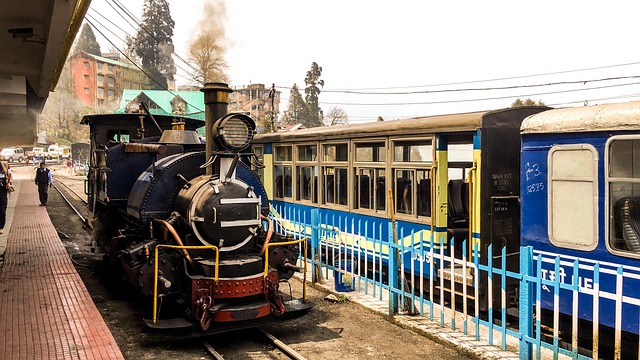The Darjeeling Himalayan Railway (DHR), also known as the “Toy Train,” is not just a mode of transport—it’s a heritage experience. Winding through the misty hills of West Bengal, this narrow-gauge railway captures the romance of train travel from a bygone era. Recognized as a UNESCO World Heritage Site, the Darjeeling Himalayan Railway remains one of the most iconic hill railways in the world.
If you’re looking to relive a slice of colonial-era charm while embracing the scenic beauty of the Eastern Himalayas, this Darjeeling Himalayan Railway guide is for you.
1. A Brief History of the Darjeeling Himalayan Railway
Constructed between 1879 and 1881, the Darjeeling Himalayan Railway was built to connect the plains of Siliguri with the cool hill station of Darjeeling. The journey, initially intended for transporting tea and British officials, soon became famous for its engineering marvels and stunning views.
In 1999, UNESCO declared it a World Heritage Site, making it the first hill railway in India to receive this recognition.
2. Route and Stations of the Darjeeling Himalayan Railway
The DHR covers a distance of 88 kilometers (about 55 miles) from New Jalpaiguri (NJP) to Darjeeling, climbing from the plains at 100 meters to over 2,200 meters.
Major Stations Include:
- New Jalpaiguri (NJP) – Starting point
- Kurseong – A peaceful hill town
- Ghum – India’s highest railway station (2,258 meters)
- Darjeeling – The final destination
This ascent includes engineering marvels such as Batasia Loop, zigzags, and spiral loops, which help the train navigate the steep climb.
3. Why the Darjeeling Himalayan Railway is So Special
✓ UNESCO World Heritage Status
The DHR is part of the Mountain Railways of India, recognized for its cultural significance and unique engineering techniques.
✓ Scenic Beauty
Rolling tea gardens, dense forests, charming villages, and panoramic views of the Himalayas—especially Kanchenjunga—make the journey mesmerizing.
✓ Vintage Charm
The train uses vintage steam and diesel engines, evoking nostalgia and offering a truly timeless experience.
✓ Engineering Feat
With more than 900 curves, loops, and zigzags, the railway is a living example of 19th-century ingenuity.
4. Types of Darjeeling Himalayan Railway Rides
You can choose from several ride options based on your interest and time:
● Full Journey (NJP to Darjeeling)
Takes around 7–8 hours; ideal for train enthusiasts and slow travelers.
● Toy Train Joy Ride (Darjeeling to Ghum and back)
Lasts around 2 hours. Popular among tourists, this short ride includes a stop at Batasia Loop and Ghum Railway Museum.
● Kurseong to Darjeeling
A scenic and shorter alternative for travelers starting mid-way.
5. Popular Attractions Along the Route
● Batasia Loop
An engineering wonder with a panoramic view of Darjeeling and snow-capped peaks. A war memorial stands in the center, honoring Gorkha soldiers.
● Ghum Railway Museum
Houses rare photos, historical documents, and model trains—ideal for those interested in the history of Indian railways.
● Tea Gardens
Watch neatly lined tea bushes along the route, with workers plucking tea leaves—a visual delight and a photography hotspot.
6. Ticket Booking and Fare Information
Tickets for the Darjeeling Himalayan Railway can be booked via the IRCTC website or directly at station counters. Fares depend on the type of ride (steam or diesel engine, class, and distance).
Joy Ride Fare (Darjeeling to Ghum round trip):
- Diesel Engine: Approx. ₹1000 per person
- Steam Engine: Approx. ₹1500 per person
Booking in advance is recommended, especially during tourist seasons (April–June and October–December).
7. Best Time to Experience the Toy Train
- Spring & Summer (March–June): Clear skies, blooming rhododendrons, and pleasant weather.
- Autumn (October–November): Crisp air, panoramic views, and festive ambiance.
- Avoid Monsoon (July–September): Landslides and heavy rains can affect service.
8. Travel Tips for a Smooth Journey
- Arrive early at the station to soak in the ambiance and avoid last-minute rush.
- Carry warm clothes—even in summer, mornings and evenings can be chilly.
- Keep a camera handy for the scenic views and vintage train interiors.
- Plan for motion sickness if you’re sensitive to winding mountain routes.
- Don’t litter—help preserve the pristine beauty of this heritage ride.
9. Cultural Significance and Legacy
The Darjeeling Himalayan Railway is more than a scenic journey—it’s deeply embedded in the region’s culture and history. It inspired Satyajit Ray’s films, countless books, and remains a cherished symbol of British-era engineering combined with local beauty.
The locals see the toy train as an integral part of their lives—its whistles, slow chug, and presence add charm to the town’s rhythm.
10. Final Thoughts
The Darjeeling Himalayan Railway is a travel experience unlike any other. It’s not just about reaching a destination but enjoying every twist, turn, and view along the way. In 2025, make time to hop aboard this mountain marvel and relive a journey steeped in history, heritage, and Himalayan magic.
Whether you’re a railway enthusiast, a photographer, or a traveler seeking charm beyond speed, the toy train promises memories that last a lifetime.

